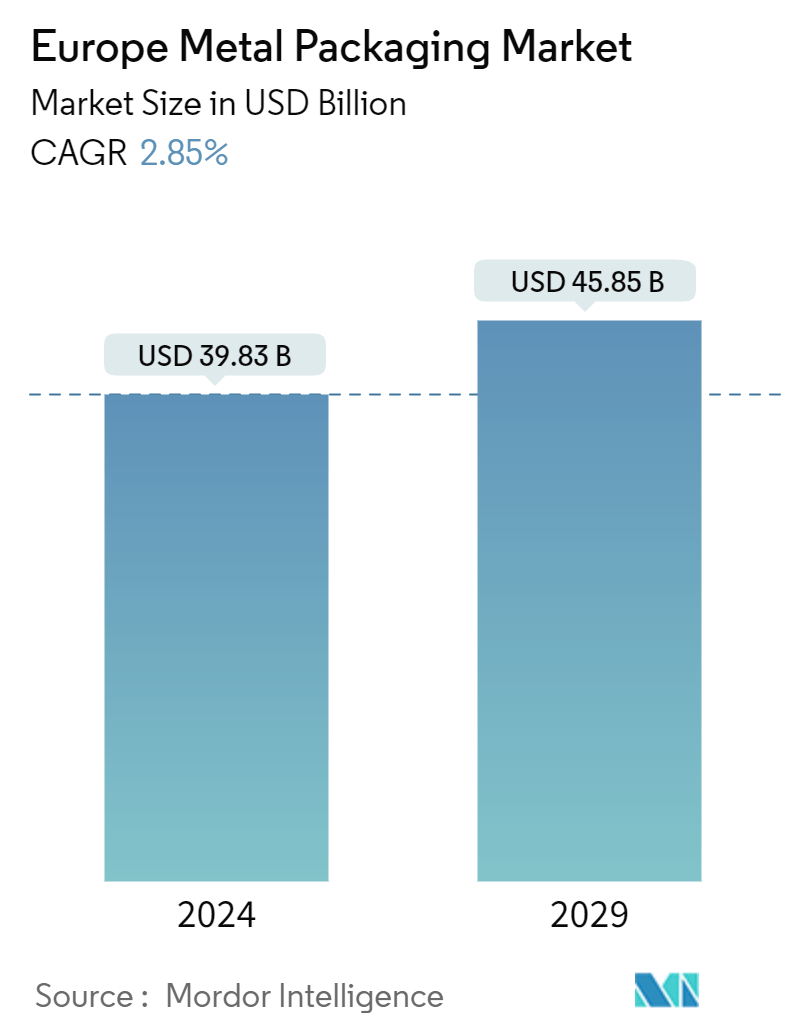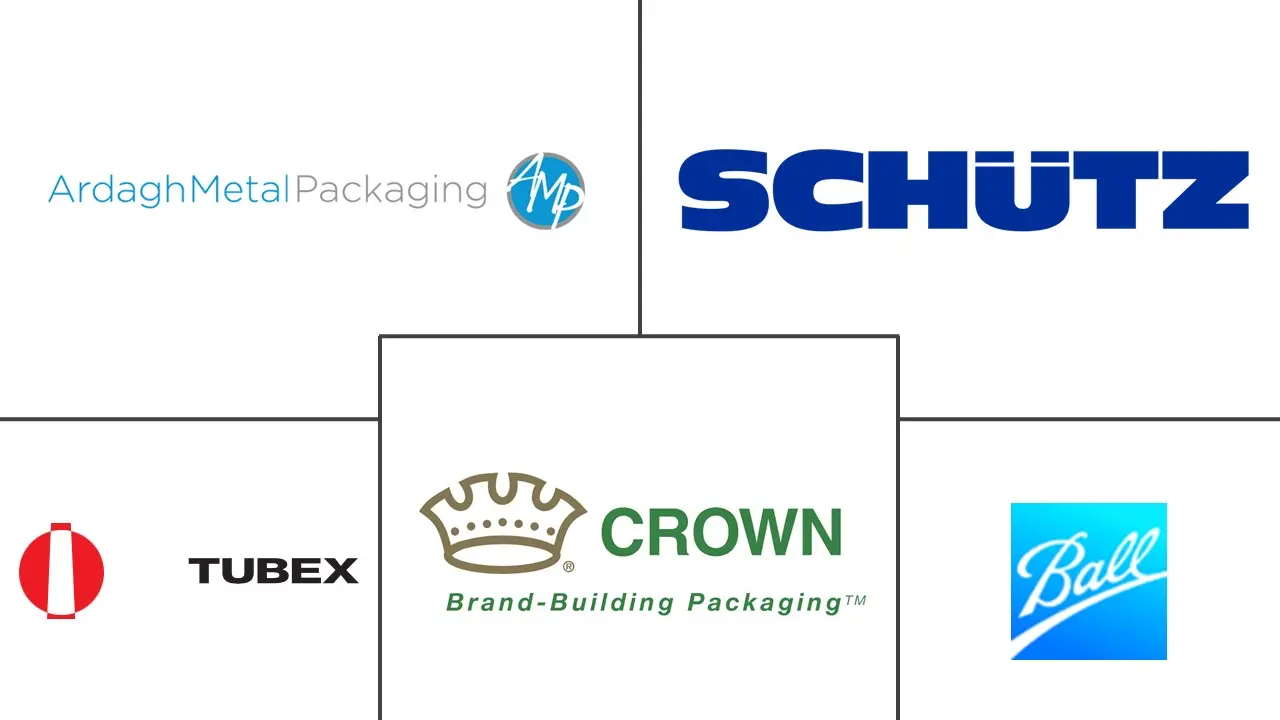Market Size of Europe Metal Packaging Industry

| Study Period | 2019 - 2029 |
| Base Year For Estimation | 2023 |
| Market Size (2024) | USD 39.83 Billion |
| Market Size (2029) | USD 45.85 Billion |
| CAGR (2024 - 2029) | 2.85 % |
| Market Concentration | Low |
Major Players
*Disclaimer: Major Players sorted in no particular order |
Europe Metal Packaging Market Analysis
The Europe Metal Packaging Market size is estimated at USD 39.83 billion in 2024, and is expected to reach USD 45.85 billion by 2029, growing at a CAGR of 2.85% during the forecast period (2024-2029).
Metal packaging has been considered the best fit for a circular economy that attracts consumers as well as product manufacturers. Metal packaging solutions have applications in all fields, including retail, wholesale, industrial, and commercial. With a proven sustainability and safety record, metal packaging solutions are considered a smart solution for brand owners and fillers.
The recyclability benefit offered by metal packaging contributes to market growth as the properties of the material do not change even after multiple recycling attempts. This gives metal packaging a competitive advantage over other packaging materials. Metal packaging is the most recycled packaging in Europe. It has the highest recycling rate in European countries, according to Metal Packaging Europe, with aluminum cans accounting for around 75% and steel packaging around 83%.
According to Metal Packaging Europe, every European citizen consumes around 4 units of metal packaging solution weekly. The use of advanced technology, along with innovation, results in new product launches, providing market growth in the region.
The increase in the trade of bulk materials such as paints and varnishes drives the demand for metal packaging solutions, including shipping barrels and drums and bulk containers. The use of advanced technologies, such as QR codes, for tracing the drums or containers containing chemical and other hazardous products is significantly helping metal packaging manufacturers to stay ahead of the competition. For instance, Duttenhofer, a German head-tight drum specialist, introduced traceability for drums containing chemicals by investing in integrated technology over the past couple of years. The QR code is printed on a label applied to the drum, containing information about the drum manufacturer, serial number, and others.
The ability of metal packaging to adhere to different technologies makes it popular among brand owners who are looking for appealing packaging products. Digital printing, embossing, and debossing technologies are used to create a visual appeal of the metal. The eye-catching metal packaging solutions help the brand gain an advantage in retail display packaging, gaining consumer attraction in the store.
Moreover, the fluctuating prices of steel and aluminum may create an obstacle for metal packaging manufacturers as this results in the increased prices of the final product. The high investment cost of setting up the metal packaging line may create a growth barrier for small and medium-scale packaging manufacturers.
Europe Metal Packaging Industry Segmentation
Metal packaging includes packaging solutions made from steel or aluminum. Metal packaging's proven safety and sustainability records make it a smart solution for brand owners and fillers. Metal packaging helps in gaining a competitive advantage over other packaging materials. It offers various benefits such as durability, versatility, safety, reusability, and recyclability. The strength and rigid nature of metal packaging help in the speed-filling process, resulting in increasing overall efficiency, including energy and CO2. In addition, the metal packaging is unbreakable, which reduces the risk of leaking or tearing during transportation.
The European metal packaging market is segmented by material type (aluminum, steel), product type (cans [food cans, beverage cans, and aerosol cans], bulk containers, shipping barrels and drums, caps and closures, and other product types), end-user industry (beverage, food, cosmetic and personal care, household, paints and varnishes, and other end-user industries), and country (United Kingdom, Germany, France, Spain, Italy, and Rest of Europe). The market sizes and forecasts are provided in terms of value (USD) for all the above segments.
| By Material Type | |
| Aluminium | |
| Steel |
| By Product Type | |||||
| |||||
| Bulk Containers | |||||
| Shipping Barrels and Drums | |||||
| Caps and Closures | |||||
| Other Product Type (Tubes, etc.) |
| By End-user Industry | |
| Beverage | |
| Food | |
| Cosmetics and Personal Care | |
| Household | |
| Paints and Varnishes | |
| Other End-user Industries (Automotive and Industrial) |
| By Country*** | |
| United Kingdom | |
| Germany | |
| France | |
| Spain | |
| Italy |
Europe Metal Packaging Market Size Summary
The European metal packaging market is poised for steady growth, driven by its alignment with circular economy principles and its widespread application across various sectors such as retail, industrial, and commercial. Metal packaging is favored for its sustainability and safety, offering significant recyclability benefits that enhance its competitive edge over other materials. The market's expansion is further supported by technological advancements and innovations, which facilitate new product launches and improve packaging appeal. The demand for metal packaging is bolstered by the increasing trade of bulk materials and the adoption of technologies like QR codes for enhanced traceability. However, fluctuations in raw material prices and high initial investment costs for setting up packaging lines pose challenges, particularly for smaller manufacturers.
In the wine and cosmetics industries, metal packaging solutions are gaining traction due to their effectiveness in preserving product quality and their environmental benefits. Metal closures for wine bottles, such as aluminum screw caps, are preferred for their ability to prevent contamination and moisture, while also being cost-effective and recyclable. The cosmetic industry, particularly in the United Kingdom, is witnessing a rise in aerosol dispensers, further driving the demand for metal packaging. The market is characterized by a fragmented landscape with numerous global and local players, who are leveraging advanced technologies and strategic acquisitions to enhance their market presence. Recent collaborations and product launches, such as innovative can designs and recycled aluminum tubes, underscore the industry's commitment to sustainability and meeting evolving consumer preferences.
Europe Metal Packaging Market Size - Table of Contents
-
1. MARKET INSIGHTS
-
1.1 Market Overview
-
1.2 Industry Value Chain Analysis
-
1.3 Industry Attractiveness - Porter's Five Forces Analysis
-
1.3.1 Bargaining Power of Suppliers
-
1.3.2 Bargaining Power of Buyers
-
1.3.3 Threat of New Entrants
-
1.3.4 Threat of Substitute Products
-
1.3.5 Intensity of Competitive Rivalry
-
-
1.4 Impact of Geopolitical Scenario on the Market
-
-
2. MARKET SEGMENTATION
-
2.1 By Material Type
-
2.1.1 Aluminium
-
2.1.2 Steel
-
-
2.2 By Product Type
-
2.2.1 Cans
-
2.2.1.1 Food Cans
-
2.2.1.2 Beverage Cans
-
2.2.1.3 Aerosol Cans
-
-
2.2.2 Bulk Containers
-
2.2.3 Shipping Barrels and Drums
-
2.2.4 Caps and Closures
-
2.2.5 Other Product Type (Tubes, etc.)
-
-
2.3 By End-user Industry
-
2.3.1 Beverage
-
2.3.2 Food
-
2.3.3 Cosmetics and Personal Care
-
2.3.4 Household
-
2.3.5 Paints and Varnishes
-
2.3.6 Other End-user Industries (Automotive and Industrial)
-
-
2.4 By Country***
-
2.4.1 United Kingdom
-
2.4.2 Germany
-
2.4.3 France
-
2.4.4 Spain
-
2.4.5 Italy
-
-
Europe Metal Packaging Market Size FAQs
How big is the Europe Metal Packaging Market?
The Europe Metal Packaging Market size is expected to reach USD 39.83 billion in 2024 and grow at a CAGR of 2.85% to reach USD 45.85 billion by 2029.
What is the current Europe Metal Packaging Market size?
In 2024, the Europe Metal Packaging Market size is expected to reach USD 39.83 billion.

